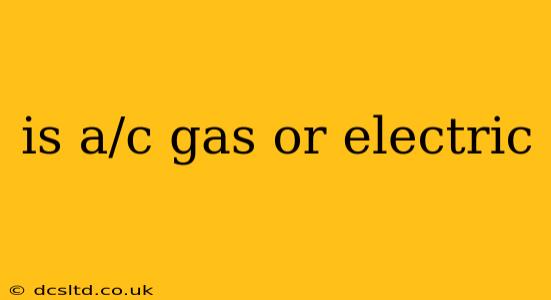Is A/C Gas or Electric? Understanding Air Conditioning Systems
The question "Is A/C gas or electric?" is a bit of a simplification. Air conditioners use both electricity and a refrigerant (often mistakenly called "gas"). They are, fundamentally, electrically powered systems that use a refrigerant to transfer heat. Let's break down how this works and clarify the role of both electricity and refrigerant.
What is the role of electricity in an air conditioner?
The electricity powers the compressor, the fan motors (both inside and outside the unit), and the control system. The compressor is the heart of the system, compressing the refrigerant and raising its temperature. The fans circulate air over the evaporator coil (inside) and condenser coil (outside) to facilitate heat exchange. Without electricity, none of these crucial components would function.
What is the role of refrigerant in an air conditioner?
Refrigerant is the key to the heat transfer process. It's a fluid that absorbs heat at a low pressure (in the evaporator coil inside your home) and releases it at a high pressure (in the condenser coil outside). This cycle of absorption and release is what cools your home. While commonly referred to as "gas," it's more accurate to describe it as a fluid that exists in both liquid and gaseous states during the cooling cycle. Different refrigerants have varying environmental impacts, with some being phased out due to their contribution to ozone depletion and global warming.
What types of refrigerants are used in A/C units?
Several refrigerants have been used throughout the history of air conditioning, each with its own properties and environmental impact. Older systems may utilize refrigerants like R-22 (now being phased out), while newer systems often use R-410A or other more environmentally friendly options. The specific refrigerant used will depend on the age and type of your air conditioning system.
What are the different types of air conditioners?
The way electricity and refrigerant interact can vary depending on the type of air conditioner. Common types include:
-
Central Air Conditioning: This system uses a network of ducts to distribute cooled air throughout a building. It requires both an indoor and outdoor unit.
-
Window Air Conditioners: These compact units are installed directly in a window and cool a single room. They are simpler and less expensive than central air systems.
-
Portable Air Conditioners: These units are self-contained and can be moved from room to room. They usually exhaust hot air via a hose.
-
Ductless Mini-Splits: These systems use an indoor unit connected to an outdoor unit via refrigerant lines but don't require extensive ductwork. They are a popular choice for additions or rooms without existing ductwork.
Is A/C gas harmful?
The refrigerant itself isn't inherently harmful in small amounts, but it's crucial to handle it with care. Leaks can be dangerous and contribute to environmental problems. Improper handling can also cause health issues. If you suspect a refrigerant leak, contact a qualified HVAC technician immediately.
In conclusion, while the term "A/C gas" is commonly used, it's more accurate to understand that air conditioners are electrically powered systems that utilize a refrigerant to cool. Both electricity and the refrigerant are essential for their operation. Understanding the interplay between these components and the different types of air conditioning systems available can help you make informed decisions about your home cooling needs.
